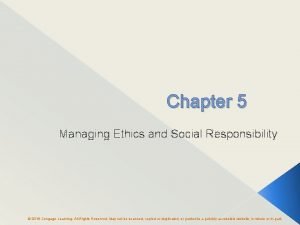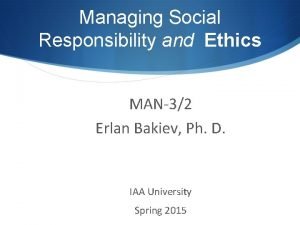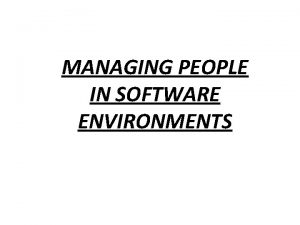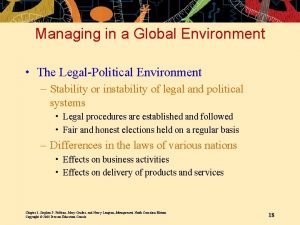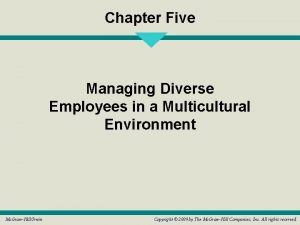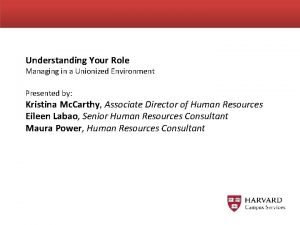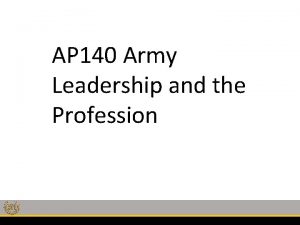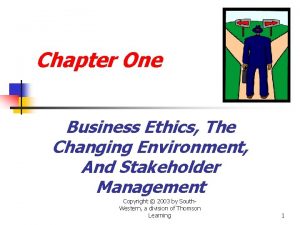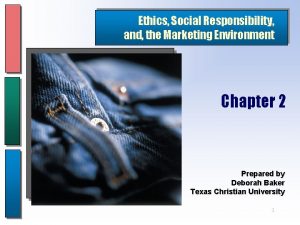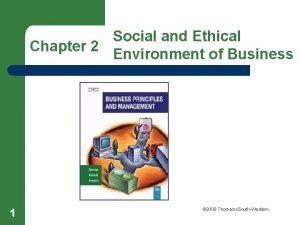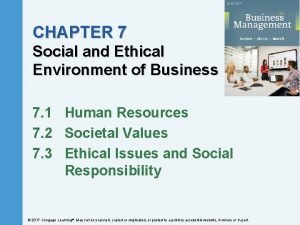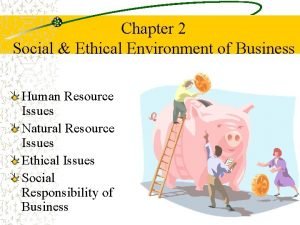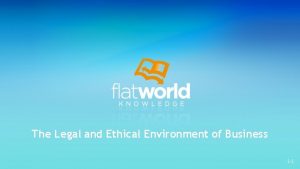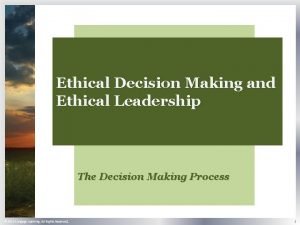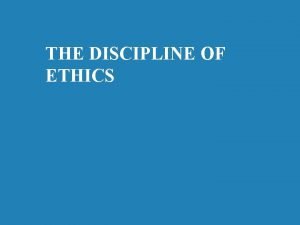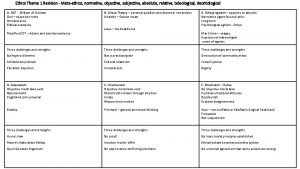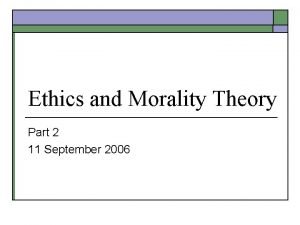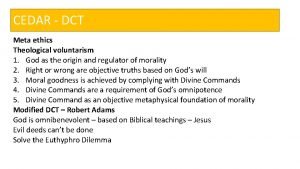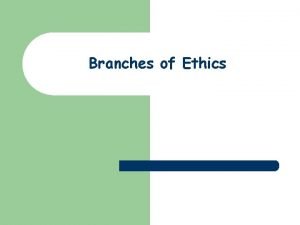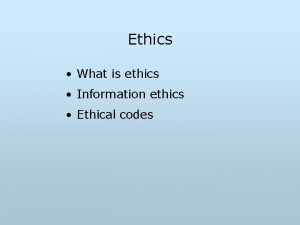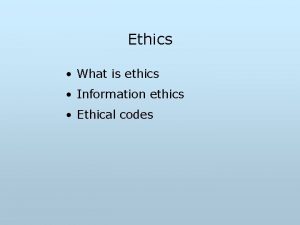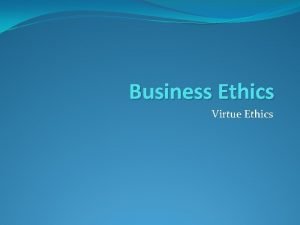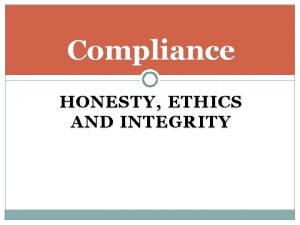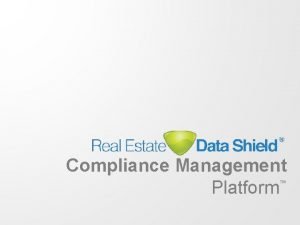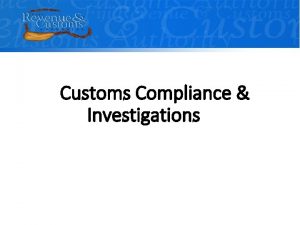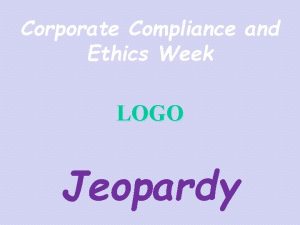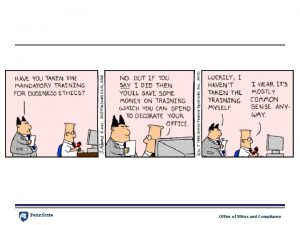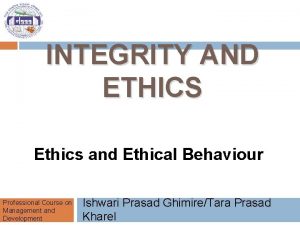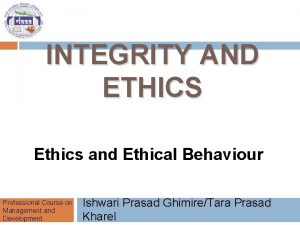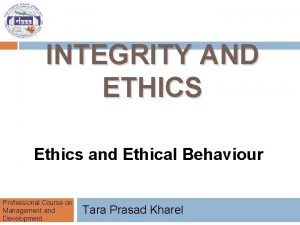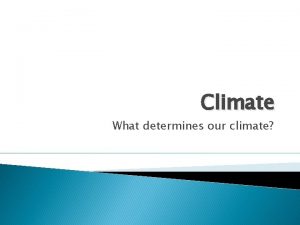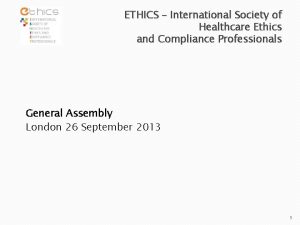Ethical Climate and Compliance Ethical Environment Managing Ethics































- Slides: 31

Ethical Climate and Compliance

Ethical Environment

Managing Ethics in Business Organizations, Trevino and Weaver (2003) “Ethics and the Broader Organizational Context: Ethical Climate and Ethical Culture”

Basic Theory • “… general theory driving this research: that the ethical context of the organization is associated with employee attitudes and behaviors. ” • THE POWER OF THE SITUATION

Concepts • Ethical culture – “the way we do things here” –beliefs, values and practices – From organizational culture • Phenomenal (observable behaviors and artifacts) and ideational (shared meanings, symbols, values) – “…various ‘formal’ and ‘informal’ systems of behavioral control that are capable of promoting either ethical or unethical behavior. ” (Trevino) • E. g. rules, reward systems, expectation to obey authority

More Concepts • Ethical climate – “the prevailing perceptions of typical organizational practices and procedures that have ethical content. ” (Victor and Cullen) • Normative expectation in the organization • 3 X 3 table: philosophy (egoism, benevolence, principled) and locus (individual, local, cosmopolitan) • Reduced to five dimensions: caring, law and code, rules, instrumental, independence

Ethical Environment • Compilation of ethical culture and ethical climate • Includes perceptions: – Whether unethical behavior disciplined and punished – Whether top management represent high standards – Whether code is only ‘window dressing’ – Whether top managers show interest in ethics – Whether code is consistent with informal, practiced norms – Whether people of integrity are rewarded

Research Question • Do ethical climate, cultures, and environments make a difference in employee attitudes, in particular commitment to the organization? • Do ethical climate, cultures, and environments make a difference in employee behaviors, in particular unethical behaviors?

Variables Studied (Related to Unethical conduct and Organizational Commitment) • • • Impression management Job satisfaction Ethical environment (aggregate) Code implementation Employee-focused management Community-focused management Self-interest Efficiency Personal ethics Law and professional codes Rules and procedures

Some Results • Empirically ethical culture and climate can be distinguished • “… an organization whose leaders represent high ethical standards and who reward ethical conduct is also an organization that values its employees, its community, and obeying the law. ” • SOCIAL CONTRACT AND SOCIAL LICENSE?

Split Sample • Code Organizations (where subjects knew there was a code) – culture factors were more important – overall ethical environment and obedience to authority • Noncode organizations (where the organization did not have a code or subject did not know of code)

More Results Related to Unethical Conduct • In Sum : – Overall best predictors of unethical conduct for culture variables: overall ethical environment and obedience to authority – Among climate variables self-interest was associated with unethical conduct • Items: – “…very concerned about what is best for themselves” – “…people protect their own interests above other considerations” – In noncode settings laws and professional standards associated with unethical conduct

Results Related to Organizational Commitment • Organizational commitment more positive when: – Reward systems support – Not unquestioning obedience to authority – Leaders pay attention to ethics and take it seriously – There is employee-focused and community-focused commitment – For noncode situations focus on selfinterest negatively related to commitment

Management Implications (Ethical Behavior) • “…have leaders who encourage and model ethical behavior and reward systems that reward ethical conduct and discipline unethical conduct, an ethics code that is consistent with norms, a focus away from strict obedience to authority and away from self interest at the expense of other considerations, and a focus on adherence to the law and professional standards when they apply. ”

Management Implications (Employee Commitment) • For achieving organizational commitment: “They can focus on developing a culture that supports ethical conduct and discourages unethical conduct through leadership, reward systems, codes, and norms. They can focus on developing climates that emphasize the good of employee, customers, and the public rather than selfinterest. ”

Compliance and Values Orientations

Compliance and Values Orientations of Ethics in Organizations From Trevino, L. K. and Weaver, G. R. (2003). “The Uses and Limits of Formal Ethics Programs, ” in Managing Ethics in Business Organizations, pp. 191 -231.


Compliance vs. Values Orientations • Ethics Programs – Organizational control systems – Align behavior with organizational goals – Ensure predictability – Methods: coercive compliance or identification and commitment to collective organizational values (social contract)

Ethics Programs • Compliance – – Phrased in legal terminology Key staff (attorney) Guidelines read like legal rules Teaching rules and sanctions • Values-Based Orientation – Shared values and abstract principles such as respect and responsibility – Key staff (HR, management, operations) – Teaching focuses more on getting commitment, inspiring, and sharing ideals

Trevino and Weaver Approach • Ethics Program Outcomes (Measures of Success) – – – – Increased ethical awareness Commitment to the organization Employee integrity Willingness to communicate openly about issues Willingness to report violations to management Improved decision making Willingness to seek advice Reduced ethical conduct

Theoretical Frameworks • Values-Based – Role identity • Symbolic interaction – Social exchange • Between organization and employee • Organizational support for shared values • Compliance-Based – Contractual exchange

Values-Based Framework or Orientation • Role identity – Symbolic interactionist and social identity theories • Learn organizational identity through expectations and interactions – E. g. “learning community” at Daniels— identity to shared values and responsibilities. Salience or not of shared values that influence identity as Daniels student.

Values-Based Framework • Organizational support – Social exchange theory (Blau) • Leaders– subordinates; organizations– members • Reciprocal social benefits and expectations – Values-based program might emphasize activities to assist employees: e. g. ethical advice and counseling, ethical mentors or colleagues, systems to clarify and develop consensus on what is ethical conduct

Some Hypotheses • More employees perceive values-based ethics programs: – H 1: more awareness of ethical issues – H 2: more willing to seek ethical advice in organization – H 3: less unethical behavior in organization – H 4: greater commitment toward organization – H 5: greater belief of personal integrity – H 6: acceptable to deliver “bad news” – H 7: higher quality decision making in the organization

Compliance Framework or Orientation • Contractual exchange – Agreement to abide by ethical and organizational rules • Possible assumption of distrust– why else have rules and discipline (social contract and enforcer) • Monitoring and discipline important – Consistent punishment sends signal of justice • More calculation and conditioning than role identification with “values” of the organization and self

Some Hypotheses • More employees perceive a compliance orientation: – H 8: Less ethical behavior – H 9: More willing to seek advice – H 10: More aware of ethical issues • More employees perceive both compliance and values-based: – H 11: More willing to report ethical behavior to management

Empirical Outcomes • Support for hypothesized relationships • Sometimes two orientations work toward same end • Fortune 1000 firms (1999)– mean for compliance orientation (4. 05) and values-based orientation (3. 94) • “Usefulness analysis”– values-based orientation displays greater explanatory power • Integrated approach may be important– valuesbased orientation may frame the purpose and role of compliance • Consider: – Placement of office: e. g. HR or Legal – Director and staff: values-based MBA’s or lawyers

Other Influences on Ethics in Organizations • Perception that ethics programs are oriented to “protect top management” • Perception that company has “formal mechanism for raising concerns” and making ethics part of performance appraisal • Perception that organization “follows through” and not mere “window dressing”

More Factors • Leadership (“tone at the top”) one of the most important factors (leaders include supervisors) • Perception of “fair treatment” (strongest relation to employee commitment and delivering ‘bad news’) • Perception that ethics is talked about and integrated into decision making • Perception that ethical behavior is rewarded (again employee commitment and delivering ‘bad news’)

In General / Summary • Ethical culture factors most important influence factors: – – Leadership Fairness perceptions Ethics discussed Ethical behavior rewarded • What hurts or inhibits: – “expectation of unquestioning obedience to authority”
 Climate change 2014 mitigation of climate change
Climate change 2014 mitigation of climate change Climate environment and resources
Climate environment and resources Managing ethics and social responsibility
Managing ethics and social responsibility Managing ethics and social responsibility
Managing ethics and social responsibility Trevino and nelson managing business ethics
Trevino and nelson managing business ethics Managing in a global environment
Managing in a global environment Managing in a global environment chapter 4
Managing in a global environment chapter 4 Managing people in software engineering
Managing people in software engineering Managing in a global environment
Managing in a global environment Managing diverse employees in a multicultural environment
Managing diverse employees in a multicultural environment Managing in a global environment chapter 4
Managing in a global environment chapter 4 Managing in a global environment
Managing in a global environment Managing in a unionized environment
Managing in a unionized environment Ethical lenses army
Ethical lenses army Business ethics and changing environment
Business ethics and changing environment The marketing environment ethics and social responsibility
The marketing environment ethics and social responsibility Chapter 2 social and ethical environment of business
Chapter 2 social and ethical environment of business Chapter 7 social and ethical environment of business
Chapter 7 social and ethical environment of business Chapter 2 social and ethical environment of business
Chapter 2 social and ethical environment of business Legal and ethical environment of business
Legal and ethical environment of business Obstructionist stance
Obstructionist stance Micro and macro issues in engineering ethics
Micro and macro issues in engineering ethics Ethical decision making and ethical leadership
Ethical decision making and ethical leadership Environment of business finance
Environment of business finance Descriptive ethics vs normative ethics
Descriptive ethics vs normative ethics Normative ethics
Normative ethics Aspects of honesty
Aspects of honesty Methaethics
Methaethics Descriptive ethics vs normative ethics
Descriptive ethics vs normative ethics Beneficence
Beneficence Metaethics vs normative ethics
Metaethics vs normative ethics Metaethics
Metaethics


